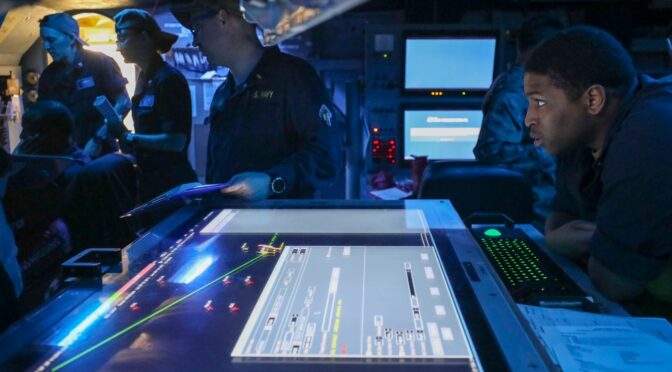By Tony Carrillo
Management makes warfighting possible, but management that enables warfighting needs to be better managed itself. Namely, overlapping lines of reporting and the lack of a strong feedback mechanism to spread the best practices of successful ships are hampering the Navy’s ability to maintain its warfighting dominance.
A quick survey reveals no fewer than ten organizations are involved with preparing a ship and evaluating its readiness for war as part of its lifecycle.1,2,3 From the Congress, to the Chief of Naval Operations (CNO), to the surface type commanders (TYCOMs) to the Naval Sea Systems Command (NAVSEA), and the Naval Education and Training Command (NETC), each organization has a plethora of subordinates who have oversight of ships. Although these entities exist for rightful reasons, repeated redundant requirements for certifications slow down the process of qualifying ships to perform missions. Unifying all efforts will streamline this process and in turn free up more time to conduct training and exercises. It will allow ships to focus on sharpening warfighting skill instead of simply passing the next inspection. Leaders can do their part by keeping proficiency high with drills and by increasing drill complexity, rather than settling for simply demonstrating the minimum required proficiency. Yet caution must be exercised to ensure that the knowledge and skills that ships acquire do not spoil. This means periodic interventions to make sure that ships do not simply “brain dump” after passing an inspection or certification.
Currently, surface forces have a near-miss and critique reporting system that requires lessons learned to be submitted to self-report mistakes made.4 However, the level of severity that necessitates a critique or near-miss is too high to learn the day-to-day lessons that are needed to develop warfighters. Successes should also be recorded in the current lessons learned system. Implementing this feedback mechanism will enable ships to learn from the successes of other ships and not just their mistakes. While this may sound like an additional administrative burden, it can be undertaken as a core component of the formal debrief process that occurs at the conclusion of inspections and evaluations of ships. Once the “all severity” lessons learned system is in place with the fleet’s assessors, then the ship training teams should be directed to participate in it as well. This will allow ships to capitalize on the best practices of other ships. An important benefit is the possible recognition of the need for and initial development of new tactics, techniques, and procedures (TTPs).
To prioritize warfighting readiness, there must be a joint effort on the part of all organizations in preparing ships for war. Overlapping requirements should be streamlined to eliminate redundancy and buy back time that can be spent on additional training and tactical development. This should be supplemented by a lessons learned system that enables ships to learn from the successes of other ships. Making these changes is vital to the Navy’s ability to maintain maritime dominance.
LT Anthony Carrillo is a Surface Warfare Officer in the U.S. Navy. He is a prospective department head and served most recently as an instructor at Surface Warfare Schools Command Newport. A 2015 graduate of Texas A&M University, he commissioned through Officer Candidate School. These views are his own and do not necessarily reflect the official position or policy of the U.S. Government, the U.S. Department of Defense, or the U.S. Navy.
References
1. “Examination of vessels; striking of vessels from the Naval Vessel Register.” 10 USC 8674. https://uscode.house.gov/view.xhtml?req=granuleid:USC-prelim-title10-section8674&num=0&edition=prelim.
2. Department of the Navy, Naval Surface Force/U.S. Pacific Fleet, COMNAVSURFPACINST 3502.7C: Surface Force Training and Readiness Manual (18 November 2022).
3. Department of the Navy, Chief of Naval Operations, OPNAVINST 9220.3A: Propulsion and Auxiliary Plant Inspection and Inspector Certification Program (Non-Nuclear) (19 August 2015).
4. Department of the Navy, Naval Surface Force/U.S. Pacific Fleet, COMNAVSURFPACINST 3040.1A CH-1: Surface Force Critiques, (15 November 2021).
Featured Image: Philippine Sea (March 3, 2022) Sailors conduct an exercise in the combat information center of Arleigh Burke-class guided missile destroyer USS Higgins (DDG 76). (U.S. Navy photo by Mass Communication Specialist 2nd Class Arthur Rosen)

